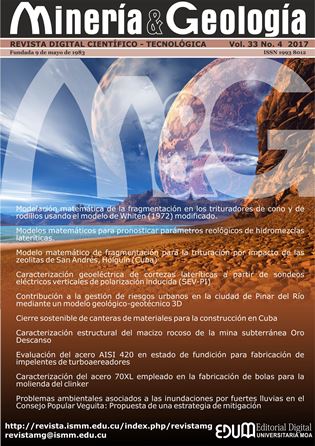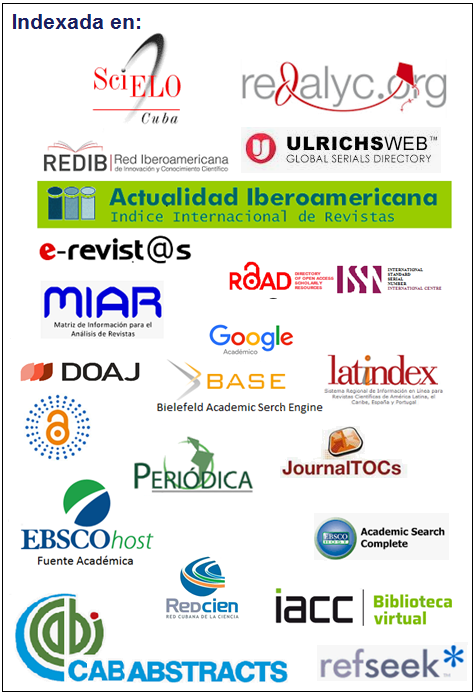Structural characterization of the rock mass of the underground mine Oro Descanso
Keywords:
underground mining, mining tillage, gold, rock mass.Abstract
In the rocky massif where the Oro Descanso underground mine is located, an assessment was made of the physical-mechanical properties of rocks, cracking and blocking, in order to propose safe tillage measures for underground mining excavations using appropriate empirical methods. From the evaluation made it was concluded that the massif is composed of areas of rocks of different quality: good, fair and poor. It is proposed for the area of good quality to work excavations with complete advance, of free length 1.0-1.5 m, using in the crown the support of cemented anchors of diameter 20 mm, length 3 m and spaced 2.5 m and apply concrete released 50 mm thick. For the zone of bad and regular quality, it is suggested to work in stepwise progression, of free length of 1-3 m and after each blasting, to install in the crown, cemented anchors of diameter 20 mm, length 4-5 m and spacing 1-2 m, placing on the sides metallic mesh, with concrete cast 50-150 mm thick.Downloads
References
BARTON, N.; LIEN, R. & LUNDE, J. 1974: Engineering Classification of Rock Mass for the Design of Tunnel Support. NGI Publication 106, Oslo. Rock Mechanics 6(4): 189-236.
BIENIAWSKI, Z. T. 1989: Engineering Rock Mass Classifications: A Complete Manual for Engineers and Geologists in Mining, Civil and Petroleum Engineering. John Wiley & Sons.
BIENIAWSKI, Z. T. 2011: Errores en la aplicación de las clasificaciones geomecánicas y su corrección. En: Conferencia magistral Adif–Geocontrol (Vol. 35).
CARTAYA, P. M. & BLANCO, R. T. 2000: Caracterización geomecánica de los macizos rocosos en minas subterráneas de la región oriental del país. Minería & Geología 17(1): 66–74.
DEERE, D. U. 1989: Rock Quality Designation (RQD) after Twenty Years. U.S. Army Corps of Engineers Contract Report GL-89-1, Waterways Experiment Station, Viksburg, MS.
DEERE, D. U.; HENDRON, A. J.; PATTON, F. D. & CORDING, E. J. 1967: Design of Surface and Near Surface Construction in Rock. In: 8th U. S. Symposium Rock Mechanics AIME. New York, p. 237-302.
DIÉGUEZ-GARCÍA, Y.; OTAÑO-NOGUEL, J. & SARGENTÓN-ROMERO, G. 2014: Diseño de voladuras de contorno en túneles. Minería & Geología 30(3): 49-66
INTERNATIONAL SOCIETY FOR ROCK MECHANICS (ISRM) 1982: Suggested Methods: Rock Characterization, Testing and Monitoring. E. T. Brown, Pergamon, London, 211 p.
NOA-MONJES, R. R. 2006: Indicaciones metodológicas para la elección del método de arranque de las rocas durante el laboreo de excavaciones subterráneas horizontales de pequeña y mediana sección en Cuba oriental. Minería & Geología 22(4): 50 p.
NOA-MONJES, R. R.; ADEOLUWA-OLAJESU, O. & QUEVEDO-SOTOVONGO, G. 2017: Caracterización ingeniera del macizo de la mina subterránea Oro Descanso. En: VII Convención de Ciencias de la Tierra: VII Congreso de Minería (MINERÍA, 2017). La Habana, Cuba, 3-7 abril.
ORESTES, R. L.; RENÉ, R. S.; SATURNINO, G. L. & GERARDO, M. C. 2010: Resumen y evaluación crítica de los trabajos anteriores. En: Ministerio de la Industria Básica Grupo Empresarial Geominsal Empresa Geominera del Centro. Villa Clara, Cuba, 78 p.
PALMSTROM, A. 1982: The volumetric joint count -a useful and simple measure of the degree of rock jointing. In: 41st International Congress. Assoc. Eng. Geol. Delphi 5: 221-228.
ZHANG, L. 2016: Engineering properties of rocks. Butterworth-Heinemann, United Kingdom.
Published
How to Cite
Issue
Section
Copyright (c) 2017 Adeoluwa Olajesu Oluwaseyi, Rafael Noa-Monjes, Gilberto Quevedo-Sotolongo

This work is licensed under a Creative Commons Attribution-NonCommercial 4.0 International License.
- Authors retain copyright and guaranteeing the right magazine to be the first publication of the work as licensed under a Creative Commons Attribution-NonCommercial that allows others to share the work with an acknowledgment of the work's authorship and initial publication in this journal.
- Authors may establish separate supplemental agreements for the exclusive distribution version of the work published in the journal (eg, place it in an institutional repository or publish it in a book), with an acknowledgment of its initial publication in this journal.
- Authors are allowed and recommended to disseminate their work through the Internet (e.g., in institutional telematic archives or on their websites) before and during the submission process, which can produce interesting exchanges and increase citations of the published work. (See The effect of open access)




